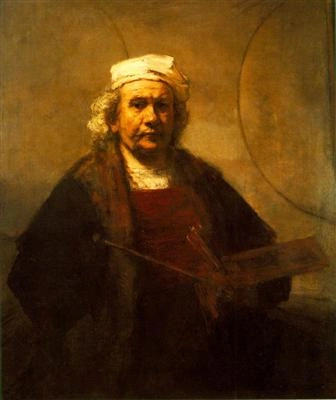Rembrandt I INTRODUCTION Rembrandt (1606-1669), Dutch baroque artist, who ranks as one of the greatest painters in the history of Western art.
Publié le 12/05/2013

Extrait du document


«
of his collection of art and antiquities, taken before an auction to pay his debts, showed the breadth of Rembrandt's interests: ancient sculpture, Flemish and ItalianRenaissance paintings, Far Eastern art, contemporary Dutch works, weapons, and armor.
Unfortunately, the results of the auction—including the sale of hishouse—were disappointing.
These problems in no way affected Rembrandt's work; if anything, his artistry increased.
Some of the great paintings from this period are The Jewish Bride (1632), The Syndics of the Cloth Guild (1661, Rijksmuseum, Amsterdam), Bathsheba (1654, Louvre, Paris), Jacob Blessing the Sons of Joseph (1656, Staatliche Gemäldegalerie, Kassel, Germany), and a self-portrait (1658, Frick Collection).
His personal life, however, continued to be marred by sorrow, for his beloved Hendrickje died in 1663,and his son, Titus, in 1668.
Eleven months later, on October 4, 1669, Rembrandt died in Amsterdam.
III EARLY PAINTING
The Anatomy Lesson of Dr.
TulpThe group portrait was an established type in Holland in the 1600s.
Prior to Rembrandt, artists placed the figures in a stiffand symmetrical arrangement.
Rembrandt places the cadaver on a diagonal and arranges the animated doctors in livelyposes around it.
The Anatomy Lesson of Dr.
Tulp (1632) is in the Mauritshuis in The Hague, Netherlands.Francis G.
Mayer/Corbis
Rembrandt probably created about 400 paintings in addition to an enormous number of drawings and etchings.
The style of his earliest paintings, executed in the1620s, shows the influence of his teacher, Pieter Lastman, in the choice of dramatic subjects, crowded compositional arrangements, and emphatic contrasts of light andshadow.
The Noble Slav (1632, Metropolitan Museum of Art, New York City) shows Rembrandt's love of exotic costumes, a feature characteristic of many of his early works.
A magnificent canvas, Portrait of a Man and His Wife (1633, Isabella Stewart Gardner Museum, Boston), shows his early portrait style—his preoccupation with the sitters' features and with details of clothing and room furnishings; this careful rendering of interiors was to be eliminated in his later works.
Members of Rembrandt'sfamily who served as his models are sometimes portrayed in other guises, as in Rembrandt's Mother as the Prophetess Anna (1631, Rijksmuseum), or the wistful Saskia as Flora, (1634, the Hermitage, Saint Petersburg).
Belshazzar’s FeastRembrandt depicts an event described in the Bible in the painting Belshazzar’s Feast (about 1635; National Gallery,London).
During the feast a hand appears and writes the Aramaic words “Mene, mene, tekel, upharsin” on the wall.
Thewords are interpreted as predicting the fall of Belshazzar's kingdom, Babylon.The National Gallery, London/Corbis
Perhaps no artist ever painted as many self-portraits (about 60), or subjected himself to such penetrating self-analysis.
Not every early portrayal, however, can beinterpreted as objective representation, for these pictures frequently served as studies of various emotions, later to be incorporated into his biblical and historicalpaintings.
The self-portraits also may have served to demonstrate his command of chiaroscuro; thus, it is difficult to tell what Rembrandt looked like from such a self-portrait as the one painted about 1628 (Rijksmuseum, on loan from the Daan Cevat Collection, England), in which deep shadows cover most of his face, barely revealinghis features.
On the other hand, in none of these youthful self-portraits did he attempt to disguise his homely features.
Biblical subjects account for about one-third of Rembrandt's entire production.
This was somewhat unusual in Protestant Holland of the 17th century, for churchpatronage was nonexistent and religious art was not regarded as important.
In Rembrandt's early biblical works, drama was emphasized, in keeping with baroque taste..
»
↓↓↓ APERÇU DU DOCUMENT ↓↓↓
Liens utiles
- John Milton I INTRODUCTION John Milton Seventeenth-century writer John Milton ranks as one of the greatest poets in the history of English literature.
- William Shakespeare I INTRODUCTION William Shakespeare English playwright and poet William Shakespeare, who lived in the late 1500s and early 1600s, is regarded as the greatest dramatist in the history of English literature.
- Charles Dickens I INTRODUCTION Charles Dickens English author Charles Dickens ranks as one of the most popular writers in the history of world literature.
- Japanese Art and Architecture I INTRODUCTION Otani Oniji as Eitoku Otani Oniji as Eitoku is one of a number of woodblock prints created by the artist T? sh ?sai Sharaku between 1794 and 1795 during the Edo period in Japan.
- Muhammad Ali I INTRODUCTION Muhammad Ali, born in 1942, American boxer, one of the greatest fighters in the history of the sport.
















